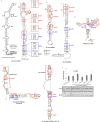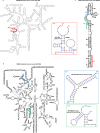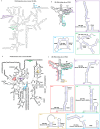Decryption of sequence, structure, and functional features of SINE repeat elements in SINEUP non-coding RNA-mediated post-transcriptional gene regulation
- PMID: 38383605
- PMCID: PMC10881587
- DOI: 10.1038/s41467-024-45517-3
Decryption of sequence, structure, and functional features of SINE repeat elements in SINEUP non-coding RNA-mediated post-transcriptional gene regulation
Abstract
RNA structure folding largely influences RNA regulation by providing flexibility and functional diversity. In silico and in vitro analyses are limited in their ability to capture the intricate relationships between dynamic RNA structure and RNA functional diversity present in the cell. Here, we investigate sequence, structure and functional features of mouse and human SINE-transcribed retrotransposons embedded in SINEUPs long non-coding RNAs, which positively regulate target gene expression post-transcriptionally. In-cell secondary structure probing reveals that functional SINEs-derived RNAs contain conserved short structure motifs essential for SINEUP-induced translation enhancement. We show that SINE RNA structure dynamically changes between the nucleus and cytoplasm and is associated with compartment-specific binding to RBP and related functions. Moreover, RNA-RNA interaction analysis shows that the SINE-derived RNAs interact directly with ribosomal RNAs, suggesting a mechanism of translation regulation. We further predict the architecture of 18 SINE RNAs in three dimensions guided by experimental secondary structure data. Overall, we demonstrate that the conservation of short key features involved in interactions with RBPs and ribosomal RNA drives the convergent function of evolutionarily distant SINE-transcribed RNAs.
© 2024. The Author(s).
Conflict of interest statement
S.G. and P.C. are inventors on patent US9353370B2 and related applications in Europe, USA and Japan, and H.S., H.T., S.G., and P.C. are inventors on patent application 102018000002411 and the related application PCT/IB2019/050914 held by SISSA in Italy and TranSINE Therapeutics in the UK, of which S.G. and P.C. are founders and H.T. owns shares. H.S., N.T., M.V., H.T., and P.C. are inventors on the E.U. patent application EP3992289A1 (WO2022090733A1) held by TranSINE Therapeutics in the UK. S.G., N.T., H.T., and P.C. are inventors on patent application WO2022064221A1 held by TranSINE Therapeutics in the UK. These competing interests were not associated with the funding of this work. The remaining authors declare no competing interests.
Figures






Similar articles
-
Genome-wide mapping of infection-induced SINE RNAs reveals a role in selective mRNA export.Nucleic Acids Res. 2017 Jun 2;45(10):6194-6208. doi: 10.1093/nar/gkx180. Nucleic Acids Res. 2017. PMID: 28334904 Free PMC article.
-
Cell Based Assays of SINEUP Non-coding RNAs That Can Specifically Enhance mRNA Translation.J Vis Exp. 2019 Feb 1;(144). doi: 10.3791/58627. J Vis Exp. 2019. PMID: 30774120
-
Genomic gems: SINE RNAs regulate mRNA production.Curr Opin Genet Dev. 2010 Apr;20(2):149-55. doi: 10.1016/j.gde.2010.01.004. Epub 2010 Feb 20. Curr Opin Genet Dev. 2010. PMID: 20176473 Free PMC article. Review.
-
Short interspersed nuclear element (SINE)-mediated post-transcriptional effects on human and mouse gene expression: SINE-UP for active duty.Philos Trans R Soc Lond B Biol Sci. 2020 Mar 30;375(1795):20190344. doi: 10.1098/rstb.2019.0344. Epub 2020 Feb 10. Philos Trans R Soc Lond B Biol Sci. 2020. PMID: 32075563 Free PMC article. Review.
-
Synthetic in vitro transcribed lncRNAs (SINEUPs) with chemical modifications enhance target mRNA translation.FEBS Lett. 2020 Dec;594(24):4357-4369. doi: 10.1002/1873-3468.13928. Epub 2020 Oct 4. FEBS Lett. 2020. PMID: 33012004
Cited by
-
Unraveling the advances of non-coding RNAs on the tumor microenvironment: innovative strategies for cancer therapies.J Transl Med. 2025 Jun 2;23(1):614. doi: 10.1186/s12967-025-06629-6. J Transl Med. 2025. PMID: 40457447 Free PMC article. Review.
-
Internal cap-initiated translation for efficient protein production from circular mRNA.Nat Biotechnol. 2025 Feb 19. doi: 10.1038/s41587-025-02561-8. Online ahead of print. Nat Biotechnol. 2025. PMID: 39972222
-
Ere, a Family of Short Interspersed Elements in the Genomes of Odd-Toed Ungulates (Perissodactyla).Animals (Basel). 2024 Jul 5;14(13):1982. doi: 10.3390/ani14131982. Animals (Basel). 2024. PMID: 38998094 Free PMC article.
-
Environmental Xenobiotics and Epigenetic Modifications: Implications for Human Health and Disease.J Xenobiot. 2025 Jul 13;15(4):118. doi: 10.3390/jox15040118. J Xenobiot. 2025. PMID: 40700165 Free PMC article. Review.
-
Internal ribosome entry sites enhance translation in trans in antisense non-coding SINEUP and circular RNAs.Nucleic Acids Res. 2025 Aug 11;53(15):gkaf788. doi: 10.1093/nar/gkaf788. Nucleic Acids Res. 2025. PMID: 40823812 Free PMC article.
References
MeSH terms
Substances
Grants and funding
LinkOut - more resources
Full Text Sources
Molecular Biology Databases

